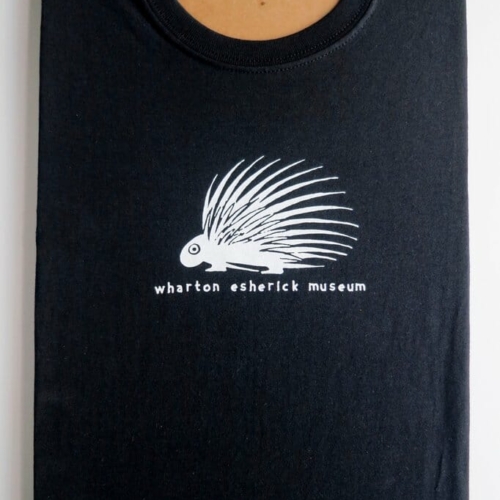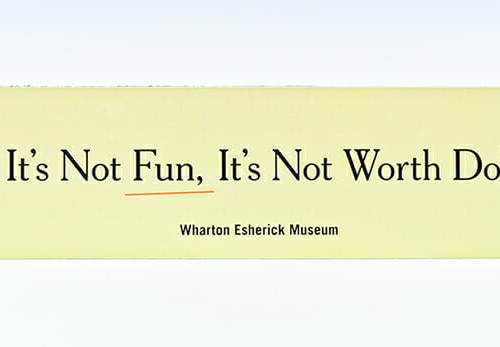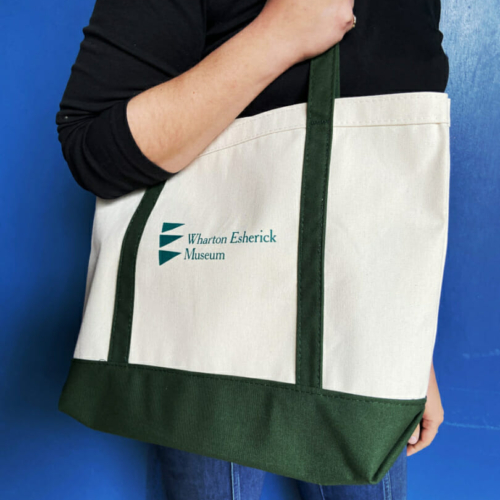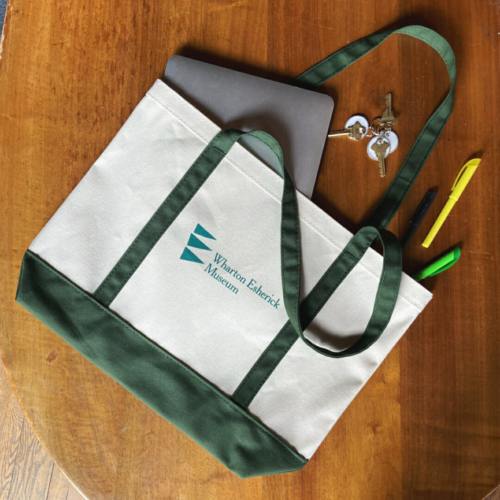-

 Wu Hanyen Pon Side Table, 2024 Elm, cork 12 1/2 x 12 1/2 x 15 inches This artwork is featured in Renewal: WEM's 31st Annual Juried Woodworking Exhibition on view through September 7, 2025. The twenty-five artists featured in this exhibition each approach renewal from a unique perspective, yet they share an interest in exploring its many manifestations through wood, whether focusing on its material properties, historical resonance, inherent narratives, or metaphorical potential. *Shipping of artworks from the Juried Woodworking Exhibition will be arranged by the artist. Please enter the coupon code juried31 at checkout to receive free shipping on these items. *Member discount cannot be applied to artworks in the Juried Woodworking Exhibition.
Wu Hanyen Pon Side Table, 2024 Elm, cork 12 1/2 x 12 1/2 x 15 inches This artwork is featured in Renewal: WEM's 31st Annual Juried Woodworking Exhibition on view through September 7, 2025. The twenty-five artists featured in this exhibition each approach renewal from a unique perspective, yet they share an interest in exploring its many manifestations through wood, whether focusing on its material properties, historical resonance, inherent narratives, or metaphorical potential. *Shipping of artworks from the Juried Woodworking Exhibition will be arranged by the artist. Please enter the coupon code juried31 at checkout to receive free shipping on these items. *Member discount cannot be applied to artworks in the Juried Woodworking Exhibition. -


Wu Hanyen
Callahan Light, 2024
Elm, linen shade, brass hardware
11 x 11 x 16 inches
This artwork is featured in Renewal: WEM's 31st Annual Juried Woodworking Exhibition on view through September 7, 2025.
The twenty-five artists featured in this exhibition each approach renewal from a unique perspective, yet they share an interest in exploring its many manifestations through wood, whether focusing on its material properties, historical resonance, inherent narratives, or metaphorical potential.
*Shipping of artworks from the Juried Woodworking Exhibition will be arranged by the artist. Please enter the coupon code juried31 at checkout to receive free shipping on these items.
*Member discount cannot be applied to artworks in the Juried Woodworking Exhibition.
-

 Artist Wharton Esherick (1887-1970) is best known for his sculptural wood pieces and the way he applied the principles of sculpture to designs for functional objects. His pioneering work has made him an inspiration to fine woodworkers worldwide, helping to elevate the medium from craft to major art museums. Much of Esherick’s work is now on display in this rural studio he built on a hillside in Pennsylvania. This catalog documents, with beautiful color photography, more than 130 paintings, woodblock prints, sculpture, and utilitarian objects found at the Wharton Esherick Museum. One gains an appreciation for the range and depth of Esherick’s work when these pieces can be studied individually.
Artist Wharton Esherick (1887-1970) is best known for his sculptural wood pieces and the way he applied the principles of sculpture to designs for functional objects. His pioneering work has made him an inspiration to fine woodworkers worldwide, helping to elevate the medium from craft to major art museums. Much of Esherick’s work is now on display in this rural studio he built on a hillside in Pennsylvania. This catalog documents, with beautiful color photography, more than 130 paintings, woodblock prints, sculpture, and utilitarian objects found at the Wharton Esherick Museum. One gains an appreciation for the range and depth of Esherick’s work when these pieces can be studied individually. -
 Wharton Esherick and the Birth of the American Modern explores Esherick’s artistic evolution during the early decades of the twentieth century, culminating in the exhibition of his work as part of the Pennsylvania Hill House at the 1940 World's Fair in New York City. Trained as an illustrator and painter, experienced in modern theater and dance, well exposed to new ideas in philosophy, politics, and literature, Esherick experimented with woodcarving and printmaking, laying the foundation for his emergence as an artist of remarkable range.
Wharton Esherick and the Birth of the American Modern explores Esherick’s artistic evolution during the early decades of the twentieth century, culminating in the exhibition of his work as part of the Pennsylvania Hill House at the 1940 World's Fair in New York City. Trained as an illustrator and painter, experienced in modern theater and dance, well exposed to new ideas in philosophy, politics, and literature, Esherick experimented with woodcarving and printmaking, laying the foundation for his emergence as an artist of remarkable range. -

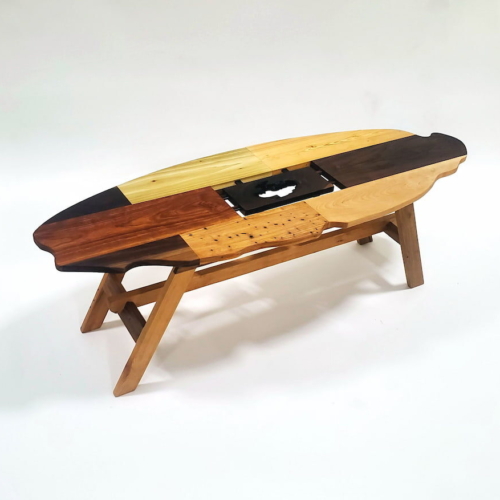
Wednesday Childs
Remnants of Impalement, 2023
Reclaimed hemlock and white oak and scraps of walnut, poplar, maple, ash, cherry, and ebony, finished with linseed oil
57 1/2 x 19 1/2 x 18 1/2 inches
This artwork is featured in Renewal: WEM's 31st Annual Juried Woodworking Exhibition on view through September 7, 2025.
The twenty-five artists featured in this exhibition each approach renewal from a unique perspective, yet they share an interest in exploring its many manifestations through wood, whether focusing on its material properties, historical resonance, inherent narratives, or metaphorical potential.
*Shipping of artworks from the Juried Woodworking Exhibition will be arranged by the artist. Please enter the coupon code juried31 at checkout to receive free shipping on these items.
*Member discount cannot be applied to artworks in the Juried Woodworking Exhibition.
-

 In 1922, Wharton Esherick showed a copy Rhymes of Early Jungle Folk, which he had illustrated with woodcut prints, to Harold Mason, owner of the Centaur Bookshop in Philadelphia. Impressed by what he saw, Mason asked Esherick to illustrate Walt Whitman’s Song of the Broad-Axe, which Mason published in a limited edition in 1924. Inspired by the woodcuts, Esherick created a hand-bound prototype book of Whitman’s poem, using prints made directly from his blocks and hand-lettering it in Esherick’s own calligraphic style. Illuminated letters were used to begin paragraphs, and spaces at the end of lines were filled with blue and yellow drawings that reflect the content of the verses. The result of this labor of love was a work of art, 17x12 inches, with pages of handmade paper, folded and uncut. This book is a reproduction of Esherick’s prototype, authorized by the Wharton Esherick Museum. Though this edition is smaller than the prototype book, the original was carefully scanned and printed to provide as true a reproduction as possible. It faithfully captures the artist’s vision and skill and, for the first time, makes this wonderful work available to the general public. It will be appreciated by all admirers of Esherick, Whitman, and lovers of fine books.
In 1922, Wharton Esherick showed a copy Rhymes of Early Jungle Folk, which he had illustrated with woodcut prints, to Harold Mason, owner of the Centaur Bookshop in Philadelphia. Impressed by what he saw, Mason asked Esherick to illustrate Walt Whitman’s Song of the Broad-Axe, which Mason published in a limited edition in 1924. Inspired by the woodcuts, Esherick created a hand-bound prototype book of Whitman’s poem, using prints made directly from his blocks and hand-lettering it in Esherick’s own calligraphic style. Illuminated letters were used to begin paragraphs, and spaces at the end of lines were filled with blue and yellow drawings that reflect the content of the verses. The result of this labor of love was a work of art, 17x12 inches, with pages of handmade paper, folded and uncut. This book is a reproduction of Esherick’s prototype, authorized by the Wharton Esherick Museum. Though this edition is smaller than the prototype book, the original was carefully scanned and printed to provide as true a reproduction as possible. It faithfully captures the artist’s vision and skill and, for the first time, makes this wonderful work available to the general public. It will be appreciated by all admirers of Esherick, Whitman, and lovers of fine books. -

 Published by Rizzoli, this 224 page book introduces Esherick’s visionary work to a broader public with essays by scholars Sarah Archer, Colin Fanning, Ann Glasscock, Holly Gore, and Emily Zilber and photographs by renowned architectural photographer Joshua McHugh.
Published by Rizzoli, this 224 page book introduces Esherick’s visionary work to a broader public with essays by scholars Sarah Archer, Colin Fanning, Ann Glasscock, Holly Gore, and Emily Zilber and photographs by renowned architectural photographer Joshua McHugh. -

 Teresa Audet Circumference VI, 2023 Cherry, dyed reed, flax and abaca paper pulp 32 x 32 x 4 inches This artwork is featured in Renewal: WEM's 31st Annual Juried Woodworking Exhibition on view through September 7, 2025. The twenty-five artists featured in this exhibition each approach renewal from a unique perspective, yet they share an interest in exploring its many manifestations through wood, whether focusing on its material properties, historical resonance, inherent narratives, or metaphorical potential. *Shipping of artworks from the Juried Woodworking Exhibition will be arranged by the artist. Please enter the coupon code juried31 at checkout to receive free shipping on these items. *Member discount cannot be applied to artworks in the Juried Woodworking Exhibition.
Teresa Audet Circumference VI, 2023 Cherry, dyed reed, flax and abaca paper pulp 32 x 32 x 4 inches This artwork is featured in Renewal: WEM's 31st Annual Juried Woodworking Exhibition on view through September 7, 2025. The twenty-five artists featured in this exhibition each approach renewal from a unique perspective, yet they share an interest in exploring its many manifestations through wood, whether focusing on its material properties, historical resonance, inherent narratives, or metaphorical potential. *Shipping of artworks from the Juried Woodworking Exhibition will be arranged by the artist. Please enter the coupon code juried31 at checkout to receive free shipping on these items. *Member discount cannot be applied to artworks in the Juried Woodworking Exhibition. -

 Talia Drury Sycamore I: Achenes, 2024 Sycamore 7 x 4 1/8 x 2 1/2 inches This artwork is featured in Renewal: WEM's 31st Annual Juried Woodworking Exhibition on view through September 7, 2025. The twenty-five artists featured in this exhibition each approach renewal from a unique perspective, yet they share an interest in exploring its many manifestations through wood, whether focusing on its material properties, historical resonance, inherent narratives, or metaphorical potential. *Shipping of artworks from the Juried Woodworking Exhibition will be arranged by the artist. Please enter the coupon code juried31 at checkout to receive free shipping on these items. *Member discount cannot be applied to artworks in the Juried Woodworking Exhibition.
Talia Drury Sycamore I: Achenes, 2024 Sycamore 7 x 4 1/8 x 2 1/2 inches This artwork is featured in Renewal: WEM's 31st Annual Juried Woodworking Exhibition on view through September 7, 2025. The twenty-five artists featured in this exhibition each approach renewal from a unique perspective, yet they share an interest in exploring its many manifestations through wood, whether focusing on its material properties, historical resonance, inherent narratives, or metaphorical potential. *Shipping of artworks from the Juried Woodworking Exhibition will be arranged by the artist. Please enter the coupon code juried31 at checkout to receive free shipping on these items. *Member discount cannot be applied to artworks in the Juried Woodworking Exhibition. -
 Steve Sinner Untitled, 2024 Maple, Watco Oil 2 5/8 x 1 1/8 x 1 1/8 inches This artwork is featured in Renewal: WEM's 31st Annual Juried Woodworking Exhibition on view through September 7, 2025. The twenty-five artists featured in this exhibition each approach renewal from a unique perspective, yet they share an interest in exploring its many manifestations through wood, whether focusing on its material properties, historical resonance, inherent narratives, or metaphorical potential. *Shipping of artworks from the Juried Woodworking Exhibition will be arranged by the artist. Please enter the coupon code juried31 at checkout to receive free shipping on these items. *Member discount cannot be applied to artworks in the Juried Woodworking Exhibition.
Steve Sinner Untitled, 2024 Maple, Watco Oil 2 5/8 x 1 1/8 x 1 1/8 inches This artwork is featured in Renewal: WEM's 31st Annual Juried Woodworking Exhibition on view through September 7, 2025. The twenty-five artists featured in this exhibition each approach renewal from a unique perspective, yet they share an interest in exploring its many manifestations through wood, whether focusing on its material properties, historical resonance, inherent narratives, or metaphorical potential. *Shipping of artworks from the Juried Woodworking Exhibition will be arranged by the artist. Please enter the coupon code juried31 at checkout to receive free shipping on these items. *Member discount cannot be applied to artworks in the Juried Woodworking Exhibition. -
Out of stock

 http://www.staceyleewebber.com/ Photo courtesy of the artist
http://www.staceyleewebber.com/ Photo courtesy of the artist -
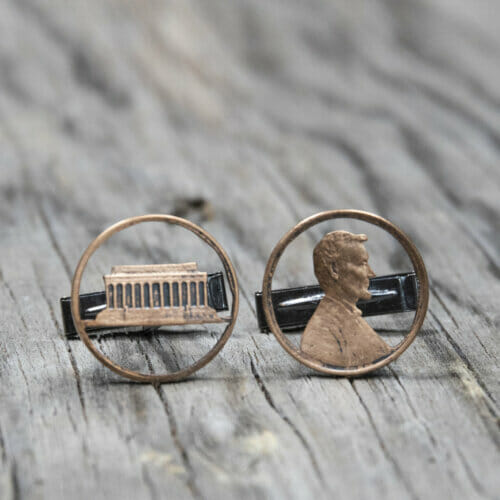 http://www.staceyleewebber.com/ Photo courtesy of the artist
http://www.staceyleewebber.com/ Photo courtesy of the artist -
 http://www.staceyleewebber.com/ Photo courtesy of the artist
http://www.staceyleewebber.com/ Photo courtesy of the artist -
 http://www.staceyleewebber.com/ Photo courtesy of the artist
http://www.staceyleewebber.com/ Photo courtesy of the artist -

 Seth Rolland Castanea spiralis, 2024 Pruned Chestnut 18 x 17 x 2 inches This artwork is featured in Renewal: WEM's 31st Annual Juried Woodworking Exhibition on view through September 7, 2025. The twenty-five artists featured in this exhibition each approach renewal from a unique perspective, yet they share an interest in exploring its many manifestations through wood, whether focusing on its material properties, historical resonance, inherent narratives, or metaphorical potential. *Shipping of artworks from the Juried Woodworking Exhibition will be arranged by the artist. Please enter the coupon code juried31 at checkout to receive free shipping on these items. *Member discount cannot be applied to artworks in the Juried Woodworking Exhibition.
Seth Rolland Castanea spiralis, 2024 Pruned Chestnut 18 x 17 x 2 inches This artwork is featured in Renewal: WEM's 31st Annual Juried Woodworking Exhibition on view through September 7, 2025. The twenty-five artists featured in this exhibition each approach renewal from a unique perspective, yet they share an interest in exploring its many manifestations through wood, whether focusing on its material properties, historical resonance, inherent narratives, or metaphorical potential. *Shipping of artworks from the Juried Woodworking Exhibition will be arranged by the artist. Please enter the coupon code juried31 at checkout to receive free shipping on these items. *Member discount cannot be applied to artworks in the Juried Woodworking Exhibition. -


Seth Rolland
Acer articulo, 2024
Pruned maple
22 x 7 x 84 inches
This artwork is featured in Renewal: WEM's 31st Annual Juried Woodworking Exhibition on view through September 7, 2025.
The twenty-five artists featured in this exhibition each approach renewal from a unique perspective, yet they share an interest in exploring its many manifestations through wood, whether focusing on its material properties, historical resonance, inherent narratives, or metaphorical potential.
*Shipping of artworks from the Juried Woodworking Exhibition will be arranged by the artist. Please enter the coupon code juried31 at checkout to receive free shipping on these items.
*Member discount cannot be applied to artworks in the Juried Woodworking Exhibition.
-

 Carved and painted wood earrings by artist Sara Tabbert. Earrings measure 2" long (wood piece is 1" long). *Please note that patterns vary slightly in each individual pair of earrings.
Carved and painted wood earrings by artist Sara Tabbert. Earrings measure 2" long (wood piece is 1" long). *Please note that patterns vary slightly in each individual pair of earrings. -

 Carved and painted wood earrings by artist Sara Tabbert. Earrings measure 2" long (wood piece is 1" long).
Carved and painted wood earrings by artist Sara Tabbert. Earrings measure 2" long (wood piece is 1" long). -

 Carved and painted wood earrings by artist Sara Tabbert. Earrings measure 2" long (wood piece is 1" long).
Carved and painted wood earrings by artist Sara Tabbert. Earrings measure 2" long (wood piece is 1" long). -

 Carved and painted wood earrings by artist Sara Tabbert. Earrings measure 2.5" long (wood piece is 2" long). *Please note that patterns vary slightly in each individual pair of earrings.
Carved and painted wood earrings by artist Sara Tabbert. Earrings measure 2.5" long (wood piece is 2" long). *Please note that patterns vary slightly in each individual pair of earrings. -

 Carved and painted wood earrings by artist Sara Tabbert. Earrings measure 2.5" long (wood piece is 2" long).
Carved and painted wood earrings by artist Sara Tabbert. Earrings measure 2.5" long (wood piece is 2" long). -

 Carved and painted wood earrings by artist Sara Tabbert. Earrings measure 2.5" long (wood piece is 2" long). *Please note that patterns vary slightly in each individual pair of earrings.
Carved and painted wood earrings by artist Sara Tabbert. Earrings measure 2.5" long (wood piece is 2" long). *Please note that patterns vary slightly in each individual pair of earrings. -
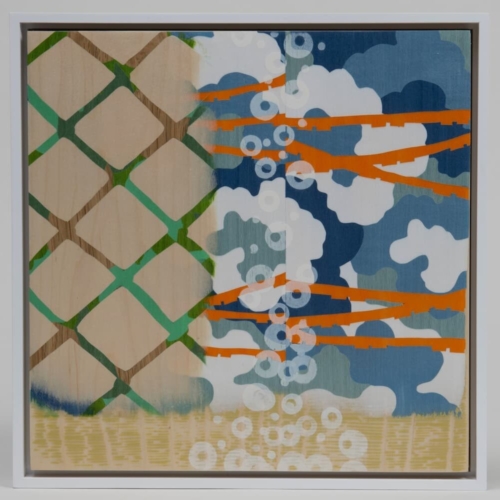 Sara Tabbert Passing Through, 2024 Wood veneer, printmaking ink, wood filler on carved cradled panel 12 x 12 inches This artwork is featured in Renewal: WEM's 31st Annual Juried Woodworking Exhibition on view through September 7, 2025. The twenty-five artists featured in this exhibition each approach renewal from a unique perspective, yet they share an interest in exploring its many manifestations through wood, whether focusing on its material properties, historical resonance, inherent narratives, or metaphorical potential. *Shipping of artworks from the Juried Woodworking Exhibition will be arranged by the artist. Please enter the coupon code juried31 at checkout to receive free shipping on these items. *Member discount cannot be applied to artworks in the Juried Woodworking Exhibition.
Sara Tabbert Passing Through, 2024 Wood veneer, printmaking ink, wood filler on carved cradled panel 12 x 12 inches This artwork is featured in Renewal: WEM's 31st Annual Juried Woodworking Exhibition on view through September 7, 2025. The twenty-five artists featured in this exhibition each approach renewal from a unique perspective, yet they share an interest in exploring its many manifestations through wood, whether focusing on its material properties, historical resonance, inherent narratives, or metaphorical potential. *Shipping of artworks from the Juried Woodworking Exhibition will be arranged by the artist. Please enter the coupon code juried31 at checkout to receive free shipping on these items. *Member discount cannot be applied to artworks in the Juried Woodworking Exhibition. -
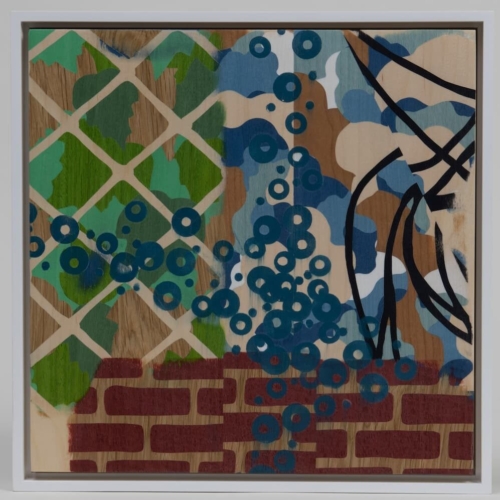 Sara Tabbert Intersection, 2024 Wood veneer, printmaking ink on cradled panel 12 x 12 inches This artwork is featured in Renewal: WEM's 31st Annual Juried Woodworking Exhibition on view through September 7, 2025. The twenty-five artists featured in this exhibition each approach renewal from a unique perspective, yet they share an interest in exploring its many manifestations through wood, whether focusing on its material properties, historical resonance, inherent narratives, or metaphorical potential. *Shipping of artworks from the Juried Woodworking Exhibition will be arranged by the artist. Please enter the coupon code juried31 at checkout to receive free shipping on these items. *Member discount cannot be applied to artworks in the Juried Woodworking Exhibition.
Sara Tabbert Intersection, 2024 Wood veneer, printmaking ink on cradled panel 12 x 12 inches This artwork is featured in Renewal: WEM's 31st Annual Juried Woodworking Exhibition on view through September 7, 2025. The twenty-five artists featured in this exhibition each approach renewal from a unique perspective, yet they share an interest in exploring its many manifestations through wood, whether focusing on its material properties, historical resonance, inherent narratives, or metaphorical potential. *Shipping of artworks from the Juried Woodworking Exhibition will be arranged by the artist. Please enter the coupon code juried31 at checkout to receive free shipping on these items. *Member discount cannot be applied to artworks in the Juried Woodworking Exhibition. -
 The Society was very pleased to have the opportunity to collaborate with Bob Bascom and the Wharton Esherick Society staff in the production of this special publication and celebrates the life of a truly remarkable woman, and shares some of the stories from her lifelong relationship with her beloved husband, their family, and the community.
The Society was very pleased to have the opportunity to collaborate with Bob Bascom and the Wharton Esherick Society staff in the production of this special publication and celebrates the life of a truly remarkable woman, and shares some of the stories from her lifelong relationship with her beloved husband, their family, and the community. -


Rosalind Sutkowski
Simulated Bark, Plank, 2019
Panoramic wooden photograph, poplar
84 x 12 x 2 inches
This artwork is featured in Renewal: WEM's 31st Annual Juried Woodworking Exhibition on view through September 7, 2025.
The twenty-five artists featured in this exhibition each approach renewal from a unique perspective, yet they share an interest in exploring its many manifestations through wood, whether focusing on its material properties, historical resonance, inherent narratives, or metaphorical potential.
*Shipping of artworks from the Juried Woodworking Exhibition will be arranged by the artist. Please enter the coupon code juried31 at checkout to receive free shipping on these items.
*Member discount cannot be applied to artworks in the Juried Woodworking Exhibition.
-

Rosalind Sutkowski
Simulated Bark #3, 2019
Wooden photograph, birch
14 x 11 x 2 inches
This artwork is featured in Renewal: WEM's 31st Annual Juried Woodworking Exhibition on view through September 7, 2025.
The twenty-five artists featured in this exhibition each approach renewal from a unique perspective, yet they share an interest in exploring its many manifestations through wood, whether focusing on its material properties, historical resonance, inherent narratives, or metaphorical potential.
*Shipping of artworks from the Juried Woodworking Exhibition will be arranged by the artist. Please enter the coupon code juried31 at checkout to receive free shipping on these items.
*Member discount cannot be applied to artworks in the Juried Woodworking Exhibition.
-
 Rosalind Sutkowski Simulated Bark #10, 2019 Wooden photograph, basswood 15 x 10 x 2 inches This artwork is featured in Renewal: WEM's 31st Annual Juried Woodworking Exhibition on view through September 7, 2025. The twenty-five artists featured in this exhibition each approach renewal from a unique perspective, yet they share an interest in exploring its many manifestations through wood, whether focusing on its material properties, historical resonance, inherent narratives, or metaphorical potential. *Shipping of artworks from the Juried Woodworking Exhibition will be arranged by the artist. Please enter the coupon code juried31 at checkout to receive free shipping on these items. *Member discount cannot be applied to artworks in the Juried Woodworking Exhibition.
Rosalind Sutkowski Simulated Bark #10, 2019 Wooden photograph, basswood 15 x 10 x 2 inches This artwork is featured in Renewal: WEM's 31st Annual Juried Woodworking Exhibition on view through September 7, 2025. The twenty-five artists featured in this exhibition each approach renewal from a unique perspective, yet they share an interest in exploring its many manifestations through wood, whether focusing on its material properties, historical resonance, inherent narratives, or metaphorical potential. *Shipping of artworks from the Juried Woodworking Exhibition will be arranged by the artist. Please enter the coupon code juried31 at checkout to receive free shipping on these items. *Member discount cannot be applied to artworks in the Juried Woodworking Exhibition. -


Richard Haining, Jr.
Tall STACKED Asymmetrical Vessel, 2024
Salvaged walnut
9 x 5 x 26 1/4 inches
This artwork is featured in Renewal: WEM's 31st Annual Juried Woodworking Exhibition on view through September 7, 2025.
The twenty-five artists featured in this exhibition each approach renewal from a unique perspective, yet they share an interest in exploring its many manifestations through wood, whether focusing on its material properties, historical resonance, inherent narratives, or metaphorical potential.
*Shipping of artworks from the Juried Woodworking Exhibition will be arranged by the artist. Please enter the coupon code juried31 at checkout to receive free shipping on these items.
*Member discount cannot be applied to artworks in the Juried Woodworking Exhibition.
-

 Richard Haining, Jr. Short STACKED Asymmetrical Vessel, 2024 Salvaged walnut 6 1/2 x 4 1/4 x 12 1/4 inches This artwork is featured in Renewal: WEM's 31st Annual Juried Woodworking Exhibition on view through September 7, 2025. The twenty-five artists featured in this exhibition each approach renewal from a unique perspective, yet they share an interest in exploring its many manifestations through wood, whether focusing on its material properties, historical resonance, inherent narratives, or metaphorical potential. *Shipping of artworks from the Juried Woodworking Exhibition will be arranged by the artist. Please enter the coupon code juried31 at checkout to receive free shipping on these items. *Member discount cannot be applied to artworks in the Juried Woodworking Exhibition.
Richard Haining, Jr. Short STACKED Asymmetrical Vessel, 2024 Salvaged walnut 6 1/2 x 4 1/4 x 12 1/4 inches This artwork is featured in Renewal: WEM's 31st Annual Juried Woodworking Exhibition on view through September 7, 2025. The twenty-five artists featured in this exhibition each approach renewal from a unique perspective, yet they share an interest in exploring its many manifestations through wood, whether focusing on its material properties, historical resonance, inherent narratives, or metaphorical potential. *Shipping of artworks from the Juried Woodworking Exhibition will be arranged by the artist. Please enter the coupon code juried31 at checkout to receive free shipping on these items. *Member discount cannot be applied to artworks in the Juried Woodworking Exhibition.

